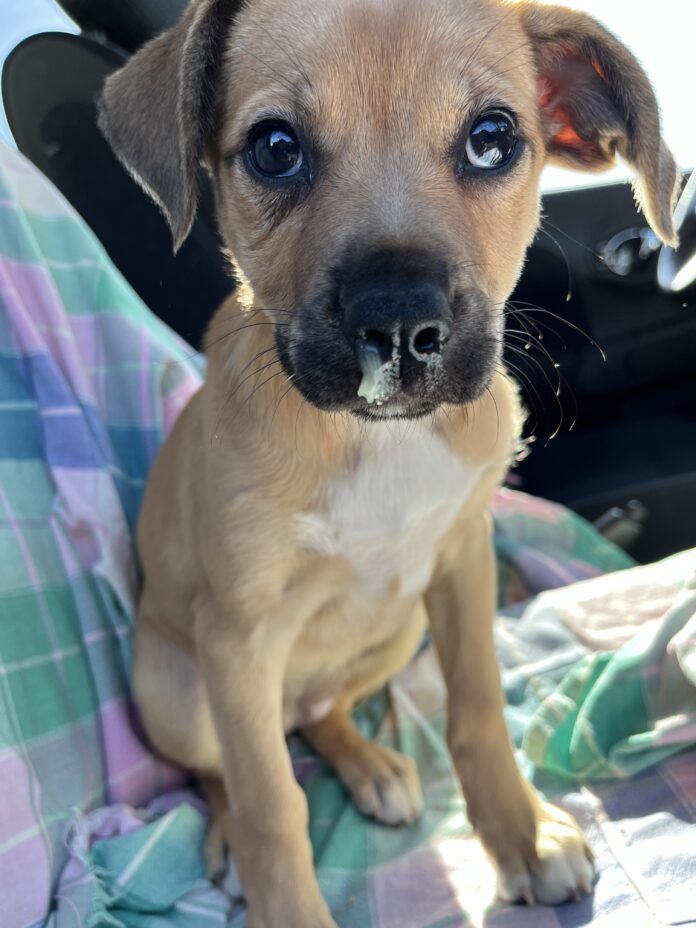
Canine influenza is caused by viruses in the influenza A family. There are two viruses in this family that can cause canine influenza: H3N2 and H3N8. The H3N8 virus made a species jump from horses to dogs in the late 1990s or early 2000s. The H3N2 virus originated in birds and was first found to infect in dogs in 2005.
Neither strain of canine influenza has been found to infect humans. However, it is possible for dogs to transmit the H3N2 strain to cats. There have been no reports of cats transmitting the H3N2 strain to dogs or people.
Symptoms of canine influenza
The symptoms of canine influenza are similar to those of any other virus or bacteria that causes infectious tracheobronchitis (kennel cough). These symptoms include a dry, non-productive cough, low-grade fever, lethargy, lack of appetite, and clear discharge from the nose and sometimes the eyes. Coughing can persist for up to three weeks. In more severe cases, the cough may become moist and productive, the nasal secretions may be yellow or green, a high fever may develop, and difficulty breathing may be observed.
Canine flu vaccine

There is a vaccine available for both the H3N2 and H3N8 strains of canine influenza. The initial dose is followed by a booster dose two to four weeks after the first vaccine is administered. The vaccine is boostered annually based on a dog’s risk of contracting canine influenza.
The canine influenza vaccine will minimize the risk of your dog contracting canine influenza. It is still possible for your dog to become sick with canine influenza even if your dog is vaccinated. But if your vaccinated dog contracts canine influenza, the vaccine will lessen the severity and duration of his illness.
Side effects of the canine influenza vaccine are similar to those seen with any other vaccine. There may be pain and swelling at the injection site. Your dog may feel a little off for 24 to 72 hours and may exhibit lethargy and disinterest in food. These signs typically resolve on their own in one to three days.
Other adverse effects are rare but may include facial swelling, hives, vomiting, or diarrhea. If you notice your dog exhibiting any of these signs, contact your veterinarian immediately.
Transmission of the canine influenza virus
Canine influenza is transmitted by coughing or sneezing, through contact with nasal secretions, and from contact with infected surfaces or clothing. The incubation period for canine influenza is one to five days. Most dogs show symptoms of canine influenza two to three days after exposure to the virus. This means that a dog could transmit canine influenza to other dogs before showing symptoms. The virus lives on surfaces and clothing for up to 24 to 48 hours and is easily inactivated by most household detergents and disinfectants.
Most dogs who contract canine influenza have had contact with other infected dogs in an indoor environment, such as a kennel, dog show, or shelter. It is possible to contract canine influenza at an outdoor venue such as a dog park, but is less likely given the free circulation of fresh air in this type of environment.
Unlike human influenza, canine influenza does not have a seasonal transmission. Dogs can contract canine influenza at any time of year. The disease has been reported in most states. There are persistent geographic hot spots and some areas where it is rarely seen, if at all. Areas where canine influenza has remained prevalent include New York City, Philadelphia, and areas of Colorado.
Diagnosing Dog Flu
Canine influenza can be diagnosed with either a PCR test or a blood test. The PCR test involves obtaining a swab sample from your dog’s nose or throat. The amount of virus shed in the nose and throat decreases with each day that your dog is sick with canine influenza, so it is possible to have canine influenza and test negative for it on this test.
The blood test looks for antibodies to canine influenza. If your dog has never been vaccinated for canine influenza and he has a high antibody level, then canine influenza is likely causing your dog’s symptoms. It is also possible to be negative on the antibody test for canine influenza and still have the disease. This is because some dogs take longer to produce antibodies when ill with canine influenza. If a second blood test two weeks later is positive for canine influenza antibodies, then that was likely the cause of your dog’s symptoms.
Caring for a dog with influenza
Most cases of canine influenza are mild and resolve on their own with supportive care at home. Supportive care may include enticing your dog to eat, making sure that fresh water is available at all times, rest, and keeping your dog away from other dogs until one week after his cough has resolved.
Complications from canine influenza
In rare circumstances, a dog with canine influenza may develop pneumonia. The canine influenza virus disrupts the lining of the respiratory tract and can allow bacteria to create a secondary infection, leading to the development of pneumonia. Dogs with pneumonia may need to be hospitalized and given intravenous fluids and antibiotics. Some dogs may also require supplemental oxygen to help them breathe. Dogs who do not require oxygen supplementation only need to be hospitalized until their fever breaks and they start eating. Dogs who require oxygen supplementation may need to be hospitalized for two or more days.
Death is rare with canine influenza, even in dogs who develop pneumonia. Dogs who die from canine influenza were typically seniors or have other underlying conditions that complicated their treatment.
Canine influenza can be prevented or minimized with vaccination. Talk to your veterinarian about your dog’s risk of contracting canine influenza and if he may benefit from receiving the canine influenza vaccine.





